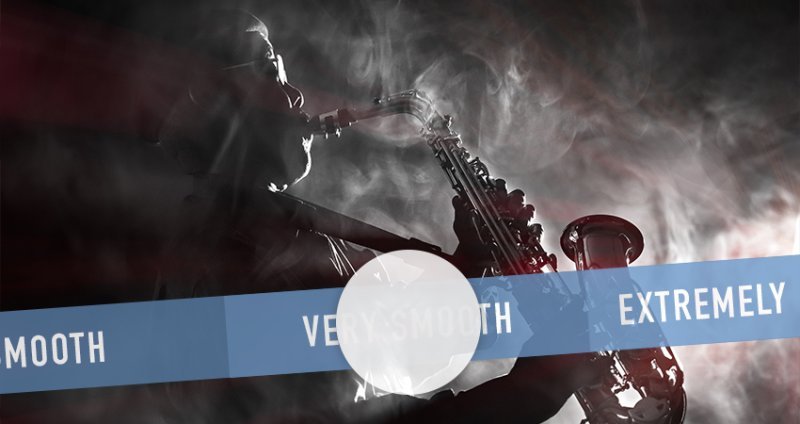Smooth Jazz is a very polarizing genre that people either come to love or hate. Some Jazz purists dislike the genre because it has “Jazz” in its name while the common folk view the artform as nothing more than boring grocery store music. While both arguments have merit, Smooth Jazz is a very dynamic genre that should not be judged by its name or the songs featured on the radio.
The Smoothness Scale was developed to provide listeners with an objective explanation of the different types of Smooth Jazz. We have arranged the genre into 3 distinct categories: Smooth, Very Smooth, and Extremely Smooth. For the purpose of this scale, we use Grover Washington Jr. - Winelight as the exemplar expression of the art form and then build from there.
If they are receptive you can move them on to the "Very Smooth Jazz" style and see if they are receptive to the increased smoothness that features less variety. If you're particularly cruel you can take it to another level of smoothness that offers no character but why do that to them? It is our opinion that listeners should move into Extremely Smooth Jazz at their own pace. Getting them to listen is half the battle, don't ruin it! Also remember that not all smoothness is good smoothness.
The Purpose of the Smoothness Scale
The Smoothness Scale was developed to provide listeners with an objective explanation of the different types of Smooth Jazz. We have arranged the genre into 3 distinct categories: Smooth, Very Smooth, and Extremely Smooth. For the purpose of this scale, we use Grover Washington Jr. - Winelight as the exemplar expression of the art form and then build from there.
Smooth Jazz

Smooth takes the free-flowing song structure of Jazz but then "smoothens it" by removing the polyrhythmic drumming, swinging, time signature changes, and improvisation that are staples in Traditional Jazz. If Smooth Jazz is order, Traditional Jazz is chaos and that's why it is a lot more palatable to a wider demographic. But as with all things, it's relative. Smooth Jazz is very chaotic and uncontrolled when compared to its "Very" and "Extremely" variants. Songs of this style are often willing to change tone and pace at any given time and are not confined to RnB and Pop structures.
Notable Track: Grover Washington - Winelight
Notable Track: Grover Washington - Winelight
Very Smooth Jazz

Very Smooth takes the smoothness a step further by removing tone/pace changes and by migrating to an RnB song structure. In this style, the lead Artist/Instrument is the focus with the backing musicians being relegated to a sometimes basic and minimally changing composition. You can often hear funk, soul, r&b, and traditional jazz influence in this type but it's often in a formulaic and restrained manner. The typical song of this style has some Black American music roots intact but begins to be weighed down by its rigidity and lack of creativity. Most tracks on the radio follow this style as it is more dynamic and carries less of a stigma.
Notable Track: Greg Manning - The One
Notable Track: Greg Manning - The One
Extremely Smooth Jazz

Extremely Smooth further distills the music by removing the influences of funk, soul, r&b, and jazz in favor of simple drum arrangements, little to no chord changes, and predictable song structure. The typical result is a track that has no highs or lows, no identifiable moments or qualities, and too rhythmically challenged to be danced to. It is the quintessential background music because it is non-offensive, doesn't distract, and doesn't evoke emotion. Often times an Artist that is known for this style will launch with a single in the style of Very Smooth Jazz to appear as if they are "breaking the mold".
Notable Track: Kenny G - Songbird
Notable Track: Kenny G - Songbird
Conclusion
When people express their contempt for the genre it typically boils down to awareness and lack of understanding that an album or track that falls on the "Extremely" side of the Smoothness Scale is not the genre has to offer. If we judged any genre by its highly distilled "Pop" variants there wouldn't be any genre worthy of praise. If you're looking to get into the genre or looking to get someone you know into it have them download Knick Smith - It's Love and see how they take to it.If they are receptive you can move them on to the "Very Smooth Jazz" style and see if they are receptive to the increased smoothness that features less variety. If you're particularly cruel you can take it to another level of smoothness that offers no character but why do that to them? It is our opinion that listeners should move into Extremely Smooth Jazz at their own pace. Getting them to listen is half the battle, don't ruin it! Also remember that not all smoothness is good smoothness.
Parting Thoughts on the "Jazz" Debate
Since Smooth Jazz lacks the defining characteristics of Jazz, many people don't see it as Jazz at all and they are not wrong. In many cases, it is R&B music that features a saxophone or other lead instrument as the "lead vocal". For example, George Benson's album Breezin', its title track and songs like L Download the app and join the community.

